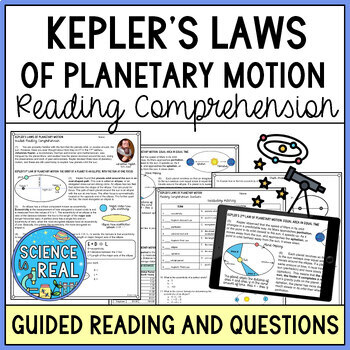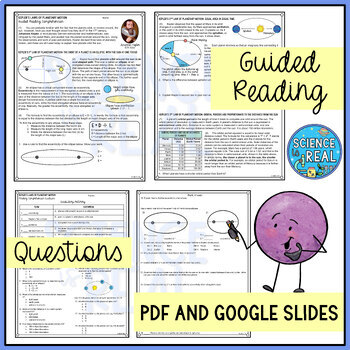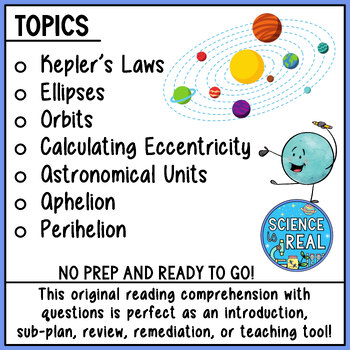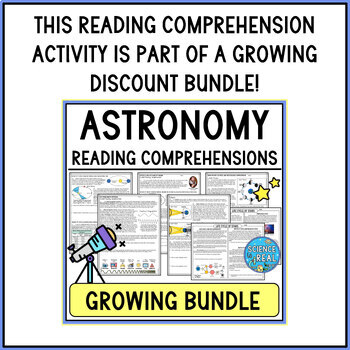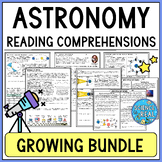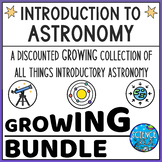Kepler's Laws Reading Comprehension Activity
- PDF
- Google Apps™

What educators are saying
Also included in
- ⭐ ⭐ ⭐ ⭐ ⭐ Save $$$ with this growing collection of Astronomy Reading Comprehensions and Questions! All resources include a printable PDF version, a Google Slides version, and answer key. Each resource includes a carefully crafted reading comprehension passage accompanied by thought-provoking questioPrice $33.90Original Price $49.90Save $16.00
- ⭐ ⭐ ⭐ ⭐ Students will get excited and learn about early astronomers, gravity, and planetary motion, with this fun mix of engaging activities. This is a growing bundle - get it before more products are added and the price is increased! With your purchase, you receive all the resources added in the fuPrice $29.77Original Price $37.21Save $7.44
- ⭐ ⭐ ⭐ ⭐ ⭐ Save Over 30% with this growing collection of all things earth science and astronomy! This is a growing collection of secondary earth science, space science, and astronomy resources. If you purchase this growing bundle today, you will receive all future added resources for free, for life!Price $456.99Original Price $653.00Save $196.01
- ⭐ ⭐ ⭐ ⭐ ⭐ Save over 30% with this growing collection of astronomy resources! This bundle includes everything I've created and will create for grades 8-12 astronomy in one place and a heavily discounted price!⭐ Click on the preview to download more information about this bundle and a digital interactPrice $159.99Original Price $230.90Save $70.91
Description
⭐ ⭐ ⭐ ⭐ How do Kepler’s Laws of Planetary Motion explain how celestial objects orbit the sun? What is an ellipse and how do you calculate eccentricity? This reading comprehension will teach your students about Kepler's Laws of Planetary Motion. After this activity, students will know and understand each law and how to apply them to objects in our solar system.
This engaging resource offers a carefully crafted reading comprehension passage accompanied by thought-provoking questions, fostering critical thinking and deep comprehension skills among learners. It includes a 2-page guided reading article and 2 pages of questions. All questions are text-dependent and do not require prior knowledge.
⭐ Includes ⭐
• Kepler’s Three Laws of Planetary Motion
• Ellipses
• Calculating Eccentricity
• Aphelion and Perihelion
• Orbital Periods
• Astronomical Units
⭐ NOW AVAILABLE IN A READING COMPREHENSION BUNDLE!!!! ⭐
Students will find Kepler’s Laws easy to understand and be able to apply these laws after reading the engaging science article. They will then answer questions that consist of multiple choice, short answer, calculating eccentricities, orbital periods, distances in space, and other content relevant thought provoking questions.
This is a fantastic lesson all on its own and would make a great homework, introductory activity, review, or sub-plan. Students do not need any prior knowledge before completing this activity and can do it all on their own!
Answers are all easily found in the content and keep the student engaged, on task, and having fun learning the content. Answer Key Included!
⭐ What you will receive:
- 4 Page Printable Version (PDF)
- Google Slides Version
- Full Answer Key
❤️ CLICK HERE TO FOLLOW SCIENCE IS REAL! ❤️
HAPPY SCIENCING!
❤️ CHECK OUT MORE GREAT RESOURCES FROM SCIENCE IS REAL! ❤️
ASTRONOMY BEST-SELLERS
⭐ Astronomy Growing Bundle - Growing Collection of Astronomy Curriculum
⭐ Astronomy PowerPoints, Notes, and Extension Activities - Growing Bundle
⭐ Astronomy Webquests - Growing Bundle
⭐ Astronomy Reading Comprehensions Bundle
⭐ Life Cycle of Stars Graphic Organizer, Reference Sheets, and Assessment
⭐ Stars Webquest - Properties and Life Cycle of Stars Webquest
⭐ Electromagnetic Spectrum Webquest
⭐ Solar System Worksheet: Diagram, Coloring, and Analysis Questions
⭐ Asteroids, Comets, and Meteors PowerPoint, Notes, & Kahoot
⭐ Gravity Lab - Weight, Mass, and Gravity Jump Lab Activity
⭐ Early Astronomy, Kepler's Laws, and Gravity PowerPoint with Notes and Kahoot
⭐ Sun Graphic Organizer with Reference Sheets and Quiz
⭐ Sun PowerPoint with Student Notes, Questions, and Kahoot
⭐ Eclipses PowerPoint with Notes and Kahoot
⭐ Moon Phases, Eclipses, and Tides Reading Comprehension Activity
Science Is Real! Terms of Use (TOU):
By purchasing this product, you own a license for one teacher only for personal use in their own classroom. Licenses are non-transferable and therefore cannot be passed from one teacher to another. If the teacher who purchased this license leaves the classroom or changes schools, the license and materials leave with that teacher. No part of this resource is to be shared with colleagues or used by an entire team, grade level, school or district without purchasing the correct number of licenses. If you are a coach, principal or district interested in transferable licenses that would accommodate yearly staff changes, please contact me for a transferable license quote at scienceisrealeducation@gmail.com
Copyright by Science is Real. Please note - all material included in this resource belongs to Ana Catts. By purchasing, you have a license to use the material, but you do not own the material. You may not upload any portion of this resource to the internet in any format, including school/personal websites or network drives unless the site is password protected and can only be accessed by students, not other teachers or anyone else on the internet.
- Dude Dots Clipart by the talented (C) Sarah Pecorino Illustrations
HAPPY SCIENCING!
❤️ CLICK TO FOLLOW SCIENCE IS REAL!
Get News of Sales, New Products, and Discounts!
Connect with Me!
Facebook
Science Is Real Website
TpT Store
⭐ JOIN THE NEW HIGH SCHOOL SCIENCE TEACHERS FACEBOOK GROUP! ⭐

